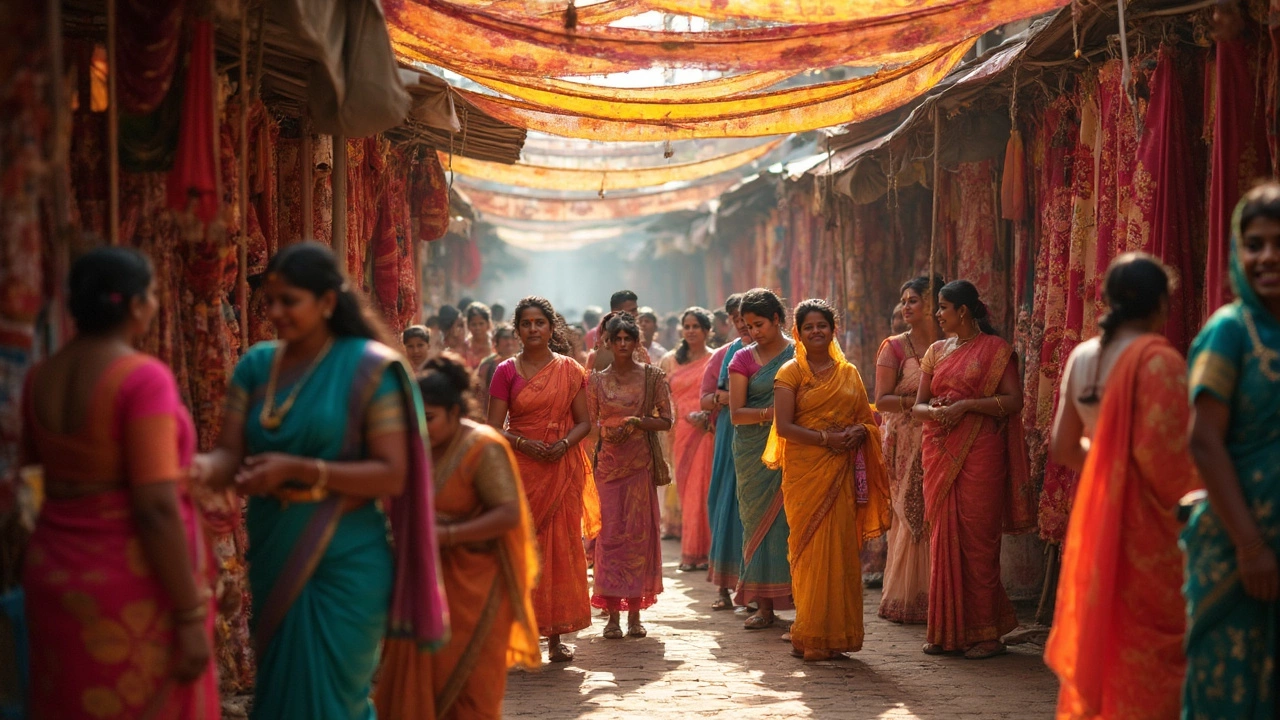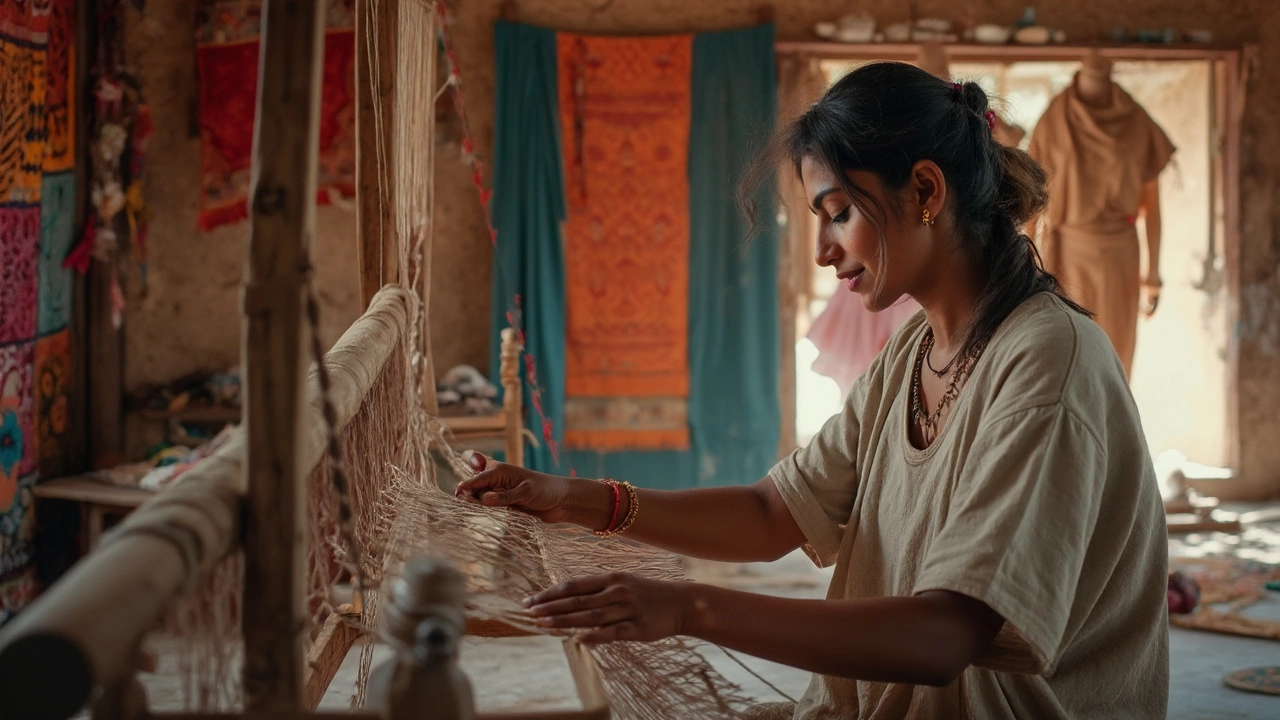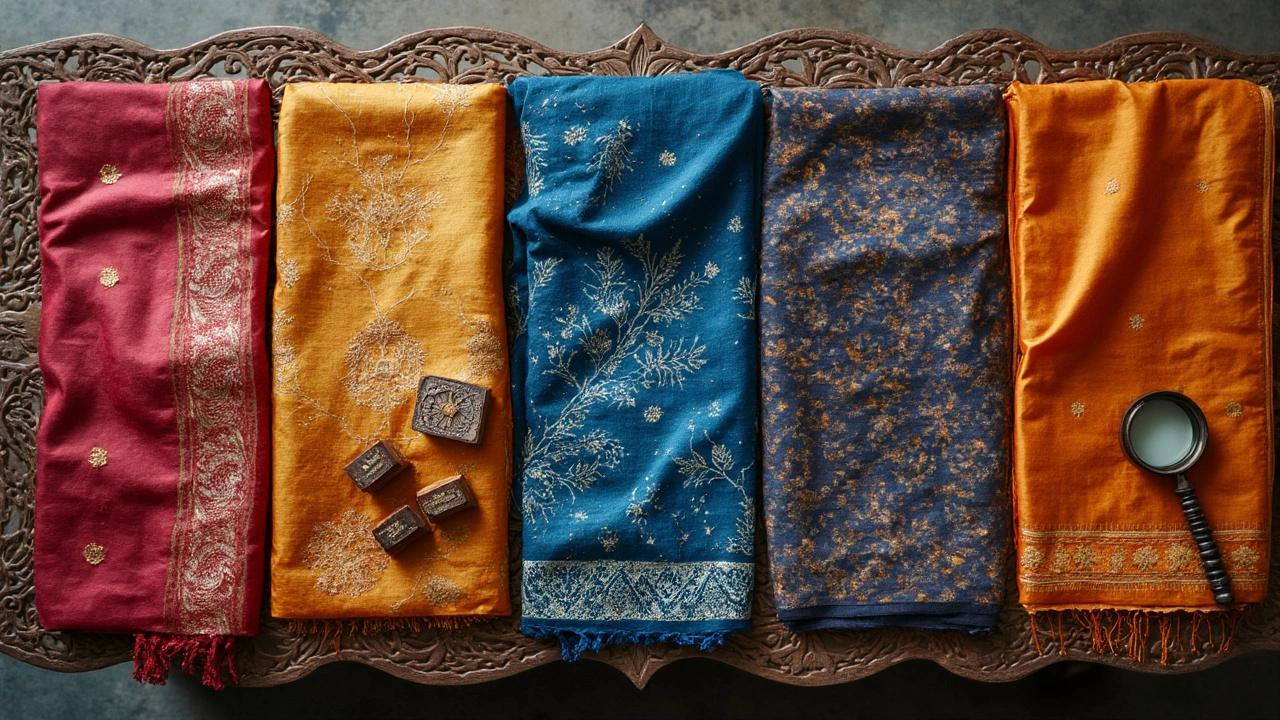 Apr, 25 2025
Apr, 25 2025
Ever wondered why people across the world rave about Indian textiles? There's a simple reason: India doesn’t just make a lot of fabric—it makes some of the very best. If you’ve walked through a street market in Jaipur or Delhi, you’ve probably seen colors that almost jump off the fabric. It’s not just about good looks, though. Indian textiles come with quality, history, and serious skill behind every weave and dye.
Take cotton for example—India was using cotton thousands of years before jeans were cool. Or silk, which still draws buyers from Paris to New York. Whether you’re after soft block-printed cottons or brocades fit for a king, India’s got a textile to match. And if you’re in the business, knowing which regions specialize in which fabrics can actually save you a lot of hassle and money. Ask any experienced fabric dealer, and they’ll have a story about being lost in the weaving lanes of Varanasi or the dye pits of Gujarat.
But don’t get tricked by fakes or mass-manufactured knock-offs. The real gems—whether it’s a handloom sari, ikat shirt, or pashmina scarf—have special traits you can spot with a sharp eye. Stick around, and you’ll learn the secrets to picking the real deal, plus how Indian manufacturers are keeping centuries-old traditions alive while scaling up for global demand.
- The Roots of India's Textile Scene
- Iconic Indian Fabrics and Where They Come From
- Why Indian Textiles Still Rule the Market
- The Modern Face of Indian Textile Manufacturing
- Tips for Choosing and Recognizing Authentic Indian Textiles
The Roots of India's Textile Scene
If you're wondering how Indian textiles became a global powerhouse, just look at its history. This industry is old—really old. Archaeologists found traces of cotton from Indian villages dating back nearly 5,000 years, around the time of the Indus Valley Civilization. That's long before most parts of the world even figured out how to spin thread.
Indian weavers and dyers figured out some clever techniques centuries ago. For example, they invented the art of block-printing, tie-and-dye (called "bandhani"), and intricate handloom weaving way before mass production hit the scene. Silk, another superstar in the Indian textiles collection, came to India by the 2nd century and was quickly picked up by royal families. By the time the British rolled in, India was already the world's top exporter of cottons and muslins—those light, airy fabrics that even European royalty wanted in their wardrobes.
The real secret sauce? Every region had its own thing going. Bengal was famous for the almost see-through muslins, Gujarat for bright bandhanis and patolas, while Varanasi kept churning out silk brocades. The handiwork was—and still is—done by families passing skills down through generations. This isn’t something you pick up in one sewing class; it takes years to master.
| Region | Famous Textile | Main Feature |
|---|---|---|
| Bengal | Muslin | Ultra-fine, super light |
| Gujarat | Bandhani, Patola | Tie-dye, double ikat |
| Varanasi | Silk Brocade | Luxurious, detailed gold and silver work |
| Tamil Nadu | Kanchipuram Silk | Rich color, heavy silk |
With such a deep heritage, it's no wonder top textile manufacturers India are trusted worldwide. The legacy isn’t just about age; it’s about perfecting the craft over thousands of years so that when someone mentions Indian textiles, you know it means something special.
Iconic Indian Fabrics and Where They Come From
If you’re trying to get your head around what Indian textiles are actually famous for, you’ve got to look at a few standouts—each with its own story and region. The variety is wild, but some names always pop up.
Cotton is where it really begins. Gujarat cranks out legendary cotton, especially Surat’s fine forms and Ahmedabad’s affordable basics. No surprise: India is still one of the world’s largest cotton producers, and these fabrics end up everywhere from local markets to top international brands. Khadi, the hand-spun and hand-woven cotton fabric, was driven nationwide by Gandhi and stands for independence as much as style. It’s light, breathable, and perfect if you’re tired of synthetic stuff.
Now, silk: If you haven’t heard of Banarasi silk from Varanasi, you’ve probably missed India’s flashiest fabric. Wedding season? Banarasi saris are all over it, known for their rich color and real gold or silver thread. Then there’s Kanchipuram silk from Tamil Nadu—thicker, bold patterns, and a big deal in the South. Mysore silk, lighter and shiny, is another classic and super-popular among designers.
Want something truly unique? Look for Ikat, where the dyeing happens on the threads before weaving, not after. Odisha, Telangana, and Gujarat make world-famous Ikat. These patterns have an almost tie-dye vibe but with a crisp, artful touch. Another hit is Bandhani (tie-dye) from Rajasthan and Gujarat—tiny knots create those wild patterns and dots you spot on dupattas and turbans.
If you want cozy luxury, Pashmina from Kashmir is the real deal. It’s painstaking—and pricey—since one goat produces only about 80 grams of wool a year. You’ll know a real Pashmina scarf: it’s super-light, warm, and passes right through a ring.
Check out this quick guide for matching fabrics to their original spots:
| Fabric | Region | What Makes It Special |
|---|---|---|
| Cotton (Khadi) | Gujarat, West Bengal | Hand-spun, breathable, historic symbol |
| Banarasi Silk | Varanasi | Gold/silver thread, rich patterns |
| Kanchipuram Silk | Tamil Nadu | Heavy, bold designs, contrast borders |
| Ikat | Odisha, Telangana, Gujarat | Tie-dyed thread, distinctive blurry edges |
| Bandhani | Rajasthan, Gujarat | Fine tie-dye, dotted patterns |
| Pashmina | Kashmir | Ultra-soft, luxurious, handwoven |
Other cool mentions: Chanderi (light silk/cotton blends from Madhya Pradesh), Kalamkari (hand-painted fabrics from Andhra Pradesh), and Dhabu (mud-resist prints from Rajasthan). Each has its target audience, price point, and distinctive technique that even veteran importers keep coming back for. That’s why textile manufacturers in India are still a top pick for so many fashion labels—whatever look you’re aiming for, there’s a city or village somewhere in India making it just the way you want.

Why Indian Textiles Still Rule the Market
There’s a reason why the phrase “Made in India” turns heads in the fabric world. Let’s talk real facts—India is the largest producer of cotton and jute in the world, and it ranks second for silk. Those aren’t just big numbers; they’re proof that when it comes to making fabric, nobody has India’s scale or variety. Walk into a major global fashion brand and you’ll find labels tracing back to Indian looms and dye-houses more often than you’d think.
But it’s not just about quantity. Indian textiles have a reputation for serious skill, from handloom weavers in Varanasi to dye masters in Rajasthan. These people aren’t churning out boring patterns either. Traditional block-printing, tie-dye (Bandhani), Ikat, and Ajrak all come from specific regions, and each technique looks—and feels—distinct.
Global buyers are hooked for a reason. Indian fabrics don’t just look cool, they last. A handwoven Kanchipuram silk sari can get passed down for generations without fading. That’s not something you see in fast fashion. Plus, India keeps prices competitive thanks to its massive pool of artisans and advanced textile manufacturers. In other words, you get top-notch quality without breaking the bank.
Check out this quick breakdown of India’s global textile impact:
| Textile Type | India's Global Rank | Main Producing State |
|---|---|---|
| Cotton | 1st | Gujarat, Maharashtra |
| Jute | 1st | West Bengal |
| Silk | 2nd | Karnataka, Andhra Pradesh |
| Handlooms | 1st | West Bengal, Tamil Nadu |
Another thing—textile manufacturers India don’t just stick to old-school work. They mix traditional skills with modern tech so you get everything from eco-friendly, organic cottons to high-end designer textiles. The government’s also pumped in support, making sure Indian fabrics stay on the world stage while the workers behind them get fairer wages.
So next time you’re choosing between fabrics and see something from India, you know you’re looking at a combo of tradition, talent, and some of the smartest manufacturing in the game.
The Modern Face of Indian Textile Manufacturing
Indian textile manufacturing has taken a huge leap in the last couple of decades. Gone are the days when it was all about small family-run workshops. Now, India’s mills and factories churn out massive quantities of fabric for global markets, and big names in Indian textiles supply brands in Europe, America, and everywhere in between. Think of places like Tiruppur for knitwear or Surat for polyester—these aren’t just local hubs, they’re global powerhouses.
A big reason for this? Investment in technology. Modern machinery helps boost both the quality and quantity of fabric produced. For example, state-of-the-art weaving and dyeing machines can make stuff that’s more durable, colorfast, and eco-friendly. Add in international certifications—like Oeko-Tex or GOTS—and you see why buyers trust textile manufacturers India for both simple and high-end orders.
What a lot of folks find cool is how the industry has kept traditional skills alive. Even with all the automation, India leads the world in things like handloom and handcrafted embroideries. So you’ll find that many top Indian textile exporters offer both bulk machine-made goods and special hand-done pieces. This gives them an edge in both mass-market and luxury segments.
Here’s a quick look at the scale and diversity in Indian textile manufacturing today:
| Region | Main Textile Produced | Notable for |
|---|---|---|
| Tiruppur | Knitwear | World’s top t-shirt supplier |
| Surat | Polyester & Synthetics | Massive export volume |
| Panipat | Home textiles | Largest exporter of rugs |
| Varanasi | Silk brocades | Handcrafted luxury fabrics |
Sustainability is another growing focus. Lots of Indian manufacturers now use organic cotton, recycle water, or switch to digital printing to cut waste. These steps help them win new customers—especially brands that care about eco-friendly practices.
If you’re sourcing from India, it helps to know which cities or states are strong in what. For big orders of basic fabrics, check out large mills in Gujarat or Maharashtra. For handcrafted, high-value famous Indian fabrics, you can’t go wrong with specialists in Andhra Pradesh, Rajasthan, or Uttar Pradesh. Always check for up-to-date certification if you care about quality or sustainability—the best factories don’t mind showing off their paperwork.

Tips for Choosing and Recognizing Authentic Indian Textiles
It’s easy to get overwhelmed by the choices when you’re shopping for Indian textiles. Prints, weaves, and dyes—everything looks tempting, but not all that glitters is real. Knowing how to spot the authentic stuff saves you both money and disappointment.
- Feel the fabric: Genuine handloom fabrics usually have an uneven texture. If it’s too smooth or perfect, it’s likely made by a machine. For silk, try the burn test—carefully pull out a few threads and burn them (if allowed by the seller). Real silk smells like burnt hair and turns to ash, while fake silk smells like plastic.
- Check the edges and reverse side: Handwoven saris and dupattas will show minor imperfections and slightly unfinished edges. Machine-made products are usually flawless.
- Look for GI tags: Many famous Indian textiles have a Geographical Indication (GI) tag. This means they’re linked to a particular region—think Banarasi silk from Varanasi or Kanchipuram silk from Tamil Nadu. Ask your seller if the fabric has this certification.
- Stains and color bleeding: Hand-dyed and natural fabrics may bleed a little initially, but synthetic dyes tend to bleed more and fade faster. Dab a damp white cloth on the fabric—if color comes off easily, it’s not high quality.
- Ask about the process: Sellers who truly know their textiles can explain how each piece was made, from loom to finish. Genuine textile manufacturers India are proud to share details about their process.
Check out this quick comparison of common authentic and fake indicators for two famous Indian fabrics:
| Fabric | Authentic Sign | Fake Indicator |
|---|---|---|
| Banarasi Silk | Intricate handwoven gold zari; minor inconsistencies on reverse | Flat machine work, no texture, glittery synthetic zari |
| Pashmina Wool | Feels soft, warm, and super light; real pashmina passes through a ring | Heavy, coarse, won't fit through a ring, usually blended fiber |
The Craftmark initiative and Handloom Mark are two more labels worth looking for—they help buyers connect with real artisanal producers instead of big factories. As Rajani Dandekar, a veteran textile expert, puts it:
"If a piece looks machine-perfect or the price feels too good to be true, chances are it’s not handloom or silk. Don’t hesitate to ask questions—authentic Indian fabrics come with stories."
Want to make sure you’re supporting ethical and genuine textile manufacturers India is known for? Visit specialist stores, ask for GI or artisan tags, and don’t shy away from touching the fabric. It’s all about informed choices—the more you know, the more you’ll appreciate the skill behind every thread.